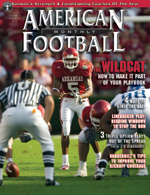Article CategoriesAFM Magazine
|
The Wildcat Comes of Age - Making it Work In Your Offenseby: David Purdum© More from this issue The Wildcat has evolved. The modern version of the single wing has surpassed the gimmick stage and blossomed into a game-changing weapon that is reportedly being used in some fashion by 80 percent of college and high school teams. The Wildcat even found a niche in the NFL, although its long-term viability at the professional level is still being debated.
|
|
|||||||
| HOME |
MAGAZINE |
SUBSCRIBE | ONLINE COLUMNISTS | COACHING VIDEOS |
Copyright 2025, AmericanFootballMonthly.com
All Rights Reserved





